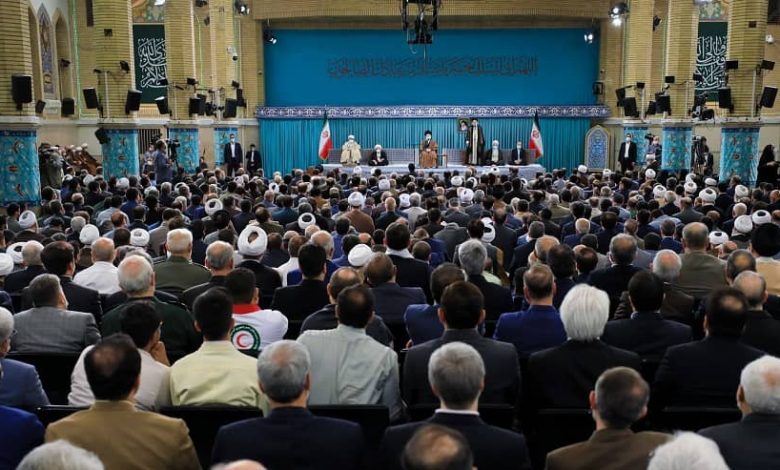Khamenei’s Speeches: A Humiliating Debacle for Iran’s Regime?

Written by
Mohammad Sadat Khansari
KhameneiThe Iranian regime’s supreme leader, Ali Khamenei, delivered two speeches this week, in which he made it clear the nationwide uprising and its persistence have created a deadlock for the ruling theocracy.
While repeating his rhetoric about overcoming the “riots” and other bogus claims, Khamenei once again underlined the necessity of oppression and that he cannot retreat a single step in the face of mounting pressure.
Referendum
In his remarks on Tuesday addressing members of the so-called “university Basij,” Khamenei once again rejected the idea of having a “referendum,” suggested by so-called reformist figures within the regime as the only way to save the mullahs’ rule.
“How can we put the country’s different issues on a referendum? Do all participants qualify to analyze those issues? What is this nonsense? How could there be a referendum? They speak about holding a referendum for six months to polarize society. No, this is not going to happen,” he said.
Those advocating for a referendum are opting to preserve the ruling theocracy but have a more share of power.
Despite witnessing the country’s volatile society due to the regime’s decades of corruption, ineptitude, and oppression, those seeking a referendum are still trying to prevent the uprising from expanding.
They do so by desperately attempting to use the so-called “system’s capabilities” as if there is a solution within a regime that the entire Iranian population wants to overthrow.
Khamenei knows the regime’s best interests, as his destiny is tied to the system’s existence. He has clearly heard people chanting “Death to Khamenei” and “Poverty, corruption, high prices, we continue until regime change” and is aware of their unwavering determination to topple the clerical regime. By blatantly rejecting the Iranian people’s right to self-determination about their country’s future, Khamenei tries to imply that he will not loosen his grip on power even a bit.
Khamenei, Raisi, and his cabinet of IRGC terrorists and torturers squander the #Iran ian people’s assets to make bombs, missiles, and drones. Thus, they keep teachers and other sectors of society under the poverty line.
— Maryam Rajavi (@Maryam_Rajavi) December 2, 2021
Acknowledging Regime’s Bankruptcy
In his speech, Khamenei considered “privatization” as the only solution to the country’s economic crunch.
“People should control the important economic sectors. I have repeatedly said governmental and semi-private companies shouldn’t compete with the private sector. We thought the government could realize economic justice, but it didn’t. Now we have to have people and the private sector to generate income,” he said.
The terms “private sector” or giving economic opportunities to “people” serve as a euphemism employed by Khamenei to denote the Revolutionary Guards (IRGC) and its economic juggernauts alongside the preeminent conglomerate of the regime’s supreme leader. Any enterprise wishing to attain substantial economic might in Iran must have ties with the IRGC.
Khamenei tacitly urged the Ebrahim Raisi government to implement the so-called “public assets plan.” This plan is being supervised by a delegation of seven high-ranking officials with full authority to decide what needs to be sold. It is an effort to cover the government’s massive budget deficit, which has been largely allotted to the IRGC.
In a nutshell, Khamenei’s wailing for the private sector’s interests once again shows the regime has no solution for Iran’s financial problems and will result in further plundering of public assets.
Now, can Khamenei proceed with his plans in the regime? His speech on Saturday during Eid-al-Fitr’s prayer sermon implies that he cannot.
Failure of a so-called “unified” system
In his speech on Saturday, Khamenei acknowledged his failure to consolidate power in his regime and among the three branches.
“A very important strategy is the cooperation between heads of three branches. They all should cooperate and synthesize. The constitution has created a perfect opportunity for them to work together; if so, they can overcome every problem. I advise the heads of the three branches not to block each other’s path and instead to pave the way for one another,” he said.
Following the major November 2019 uprising that rattled his regime’s foundations, Khamenei realized that the slightest disunity in his regime could lead to the ruling theocracy’s demise. So, he began “consolidating power.” He first purged the candidates of the rival faction in the sham parliamentary elections in 2020 and literally handpicked parliamentarians. In June 2021, Khamenei ensured the victory of Ebrahim Raisi in the sham presidential elections, despite an unprecedented nationwide boycott and Raisi’s dark human rights record. A few weeks later, the Supreme Leader installed Gholam Hossein Mohseni-Eje’I, another notorious criminal, as the head of the judiciary.
Watch how the regime in #Iran is adding to the momentum of the increasing poverty in the country and judge if #Khamenei is eventually going to pay the price for it. pic.twitter.com/odqSyGoNeE
— NCRI-FAC (@iran_policy) April 3, 2023
Khamenei described Raisi’s presidency as the “sweetest event” in 2021. Less than two years, Raisi’s failure to address the country’s economic and social crises has increased the regime’s infightings. With the dismissal and resignation of five key cabinet members, four Ministers, and the head of the Planning and Budget Organization, Raisi holds the record of changes in a cabinet in the last 44 years. Besides, there have been growing calls in the regime’s parliament for his impeachment.
The consistency of the nationwide uprising in the last seven months, despite the regime’s severe crackdown, and the prospect of a more extensive and devastating wave of dissent have exacerbated the regime’s infighting, preventing Khamenei from consolidating power in his regime.
While Ali Khamenei is not known for exposing himself to criticism and refrains from public appearances when possible, addressing his supporters twice in less than a week and calling for unity was a humiliating debacle for him after his “victory” rhetoric. The Iranian people’s unwavering determination to topple the clerical regime has revealed its weakness and its bleak future.

